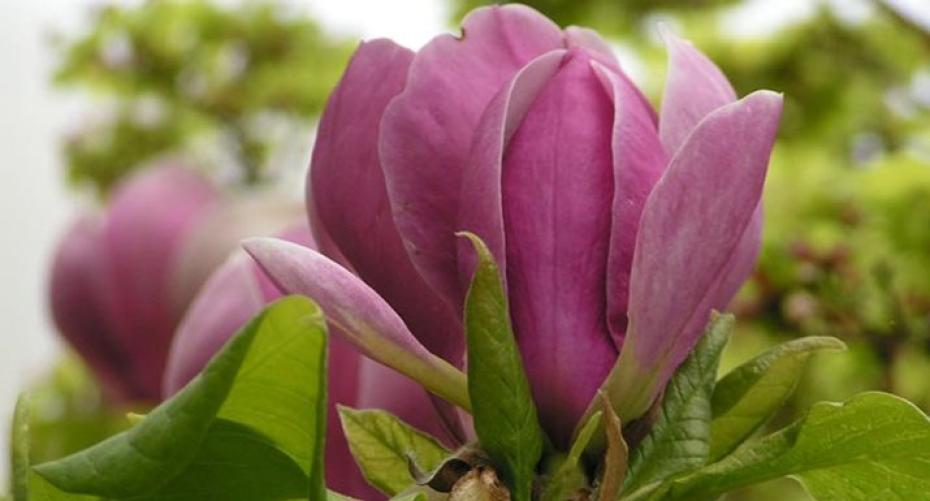Magnolia soulangeana 'Lennei'
Heavy clay soil is a challenge to gardeners but there are solutions
Heavy clay soils are the result of too much clay and silt particles and too little humus, organic matter. The clay particles bind together and form heavy clumps which hold the water, are difficult to work and also difficult for plant roots to penetrate. This results in the soil not being suitable for the majority of plants unless the soil is improved or you use plants which have adapted to living in cold, wet soil which can bake hard in summer.
The remedy is to improve the soil structure by increasing the organic content, which opens up the structure and prevents clumps forming. This open structure allows better drainage and better root growth. Unfortunately it is very labour intensive and may need to be carried out for several years before you achieve a nice friable soil. There are several remedies available:
Double dig in the autumn. Dig a trench 2 spades deep, turn the next trench into the first and so on until all the plot has been turned over. This exposes the clay which is then left over winter for the frost to break down. If used by itself this method doesn’t improve the organic content or the soil structure on a permanent basis.
Dig in Clay Breaker or gypsum. This alters the chemical composition of the clay and prevents the particles from sticking together, so forming clumps. If used by itself this method doesn’t improve the organic content or the soil structure on a permanent basis.
Dig in composted bark. You need to add at least a 75 – 100cm (3” – 4”) layer of bark or compost. A 100ltr bag should cover an area of 10 square metres. It needs digging in to a depth of at least 30cm (12”).
Dig in composted garden waste or bought peat free compost. This is a good substitute for peat, which is no longer an environmentally friendly product. This method improves the soil structure and also adds some nutrients. Use as described for composted bark.
Dig in well composted farmyard manure. This improves the soil structure but only adds very few nutrients.
Dig in conifer needles if you want to keep the ph low in order to grow rhododendrons, azaleas, camellias, conifers or heathers.
There are some plants which can cope with the heavy wet conditions in winter and the drying out in summer. If the soil is regularly completely waterlogged in winter then it is not advisable to just rely on planting as even they will suffer.
Recommended plants;
Trees; Abies, Acer (not Japanese), Aesculus, Betula, Carpinus betulus ‘Fastigiata’, Chamaecyparis, Crataegus, Cryptomeria, Cyperus, Eucalyptus, Fraxinus excelsior ‘Jaspidea’, Ilex, Juniperus, Laburnum x watereri ‘Vossii’, Larix, Magnolia, Malus, Metasequoia, Populus, Pinus, Prunus, Pyrus salicifolia ‘Pendula’, Quercus, Salix, Sorbus, Taxus, Thuja, Tilia
Shrubs; Abelia, Aucuba japonica, Berberis, Chaenomoles, Choisya ternate, Cornus, Corylus avellana ‘Contorta’, Cotinus, Cotoneaster, Cytisus, Deutzia, Escallonia, Forsythia, Genista, Hamamelis, Hibiscus syriacus, Ilex, Kerria japonica & cultivars, Mahonia, Osmanthus, Philadelphus, Pieris japonica, Potentilla, Rhododendron, Ribes, Rosa canina, Rosa eglanteria, Rosa pimpinellifolia, Rosa rugosa, Skimmia, Spiraea, Symphoricarpus, Syringa, Viburnum, Weigela
Herbaceous perennials; Aconitum, Ajuga reptans, Anemone x hybrid & cultivars, Aster, Campanula, Digitalis, Echinops, Erigeron, Geranium, Helenium, Helleborus, Hemerocallis, Hosta, Hypericum, Lysimachia clethroides, Lythrum, Monarda, Persicaria bistorta ‘Superba’, Physalis alkekengi, Polemonium, Ranunculus, Rheum palmatum, Rodgersia, Rudbeckia, Sidalcea ’Oberon’, Solidago, Tradescantia

Wisteria sinensis
Climbers; Hedera helix & cultivars, Lonicera, Pyracantha, Rosa ‘Cecile Brunner’, Rosa ‘Compassion’, Rosa ‘Constance Spry’, Rosa ‘Leverkusen’, Rosa ‘Maigold’, Rosa ‘Mme. Alfred Carriere’, Rosa ‘New Dawn’, Rosa ‘Shropshire Lass’, Rosa ramblers, Wisteria
Ferns; Matteuccia, Osmunda, Woodwardia
Bulbs; Camassia, Crocosmia, Galanthus, Leucojum




![Kingsbury-bench-05[1].jpg](http://www.hayesgardenworld.co.uk/cdn/shop/files/Kingsbury-bench-05_5B1_5D.jpg?v=1712162737&width=1500)
![Kingsbury-bench-01[1].jpg](http://www.hayesgardenworld.co.uk/cdn/shop/files/Kingsbury-bench-01_5B1_5D.jpg?v=1712161065&width=1500)
![tw17a-4947_0[1].jpg](http://www.hayesgardenworld.co.uk/cdn/shop/files/tw17a-4947_0_5B1_5D.jpg?v=1712161495&width=1500)
![tw17a-4947_tenbury_5ft[1].jpg](http://www.hayesgardenworld.co.uk/cdn/shop/files/tw17a-4947_tenbury_5ft_5B1_5D.jpg?v=1712161172&width=1500)
![tw17a-4952_tenbury_4ft[1].jpg](http://www.hayesgardenworld.co.uk/cdn/shop/files/tw17a-4952_tenbury_4ft_5B1_5D.jpg?v=1712161034&width=1500)
![thumbnail_IMG_1565-kik_2[1].jpg](http://www.hayesgardenworld.co.uk/cdn/shop/files/thumbnail_IMG_1565-kik_2_5B1_5D.jpg?v=1712226536&width=1500)
![thumbnail_IMG_1565-kik_1[3].jpg](http://www.hayesgardenworld.co.uk/cdn/shop/files/thumbnail_IMG_1565-kik_1_5B3_5D.jpg?v=1712159637&width=1500)



![WD-XgESA[1].jpeg](http://www.hayesgardenworld.co.uk/cdn/shop/files/WD-XgESA_5B1_5D.jpg?v=1712159609&width=1500)